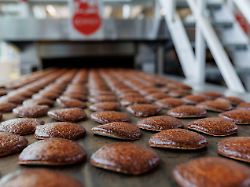Printen, dominoes, gingerbread
“Cost tsunami” hits producers of Christmas cookies
08/20/2023 06:44 am
In summer, the ovens in the Christmas bakeries are in full swing. Gingerbread and Stollen should be on the supermarket shelves as early as September. However, high energy and commodity prices could make for unusually expensive delicacies this year.
There are still four months until Christmas, but the production of gingerbread, stollen, chocolate Santa Claus and other specialties has long been in full swing. At Lebkuchen-Schmidt in Nuremberg, the large ovens are currently baking the traditional Nuremberg gingerbread and other pastries around the clock, six days a week. The situation is similar at the Lambertz Group in Aachen, where employees have been increasingly producing Aachener Printen, Nuremberg Lebkuchen and Dresden Stollen since June.
The first Christmas treats will be available in stores as early as September. It depends on the weather whether consumers want to nibble on them. According to the Federal Association of the German Confectionery Industry, the main sales period for gingerbread, Printen, dominoes and other Christmas sweets is from September to December. If it stays summery in September, things don’t really get going until October.
The traditional Nuremberg company Lebkuchen-Schmidt, for example, makes its main turnover in the last quarter of the year. The Thuringian chocolate manufacturer Viba also makes around a third of its annual turnover with Christmas items such as Santa Clauses. The first goods will go out at the end of August. German manufacturers produced almost 87,600 tons of gingerbread last year, as reported by the Federal Statistical Office on request. A year earlier it was 84,500 tons. As a result, 22,900 tons of the popular Christmas biscuits were exported in 2022. The majority of them to other European countries, especially to Poland, Austria and France.
“An important sales area is Eastern Europe, where gingerbread is consumed all year round, so traditionally it is not just seen as a seasonal product,” explains Lambertz spokesman Martin Heinen. The companies belonging to the group sell gingerbread, Printen, Stollen and Co. in more than 60 countries. Heinen says that the demand for original German Christmas specialties has increased, particularly in the USA and Great Britain.
“Classics are especially popular”
The manufacturer Lebkuchen-Schmidt, which ships its specialties from Nuremberg to every country in the world except North Korea, is also seeing increased interest in Asia and North America. “German tradition and traditional craftsmanship are in demand there like never before,” says Managing Director Jürgen Brandstetter. Tradition is also the best thing for Christmas specialties here in Germany. “There really aren’t any trends when it comes to gingerbread, the classics are what’s in demand here – with careful innovations,” Brandstetter emphasizes. For example gingerbread with a fine touch of orange or as a confection.
The production of gingerbread consumes a lot of energy, and the prices for raw materials such as sugar have also risen. Consumers could therefore sometimes have to pay more for sweets during the Advent season this year. “Unfortunately, a price adjustment cannot be avoided this year after we were able to absorb many increases last year,” says Brandstetter from Lebkuchen-Schmidt.
Lambertz even speaks of a “cost tsunami” for raw materials, energy, packaging, logistics and personnel. Spokesman Heinen cannot say how this will affect retail prices. In the case of seasonal baked goods, however, the price increases have always been moderate compared to other baked goods groups, he says. On the other hand, he does not expect people to save on gingerbread and stollen: Consumption has remained constant in the past. “When it comes to Christmas and Advent, people don’t like to go without.”
